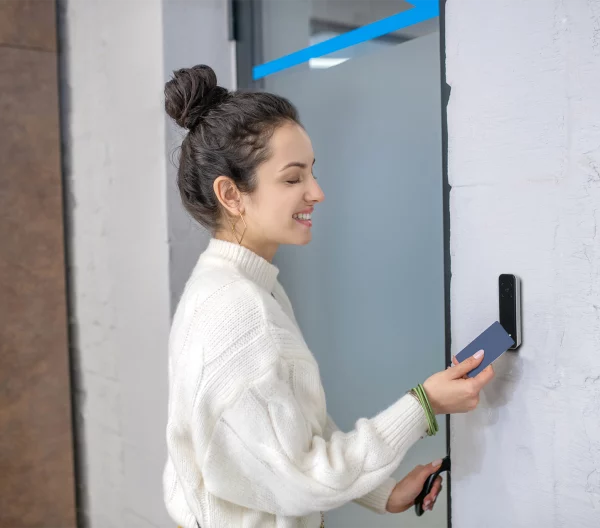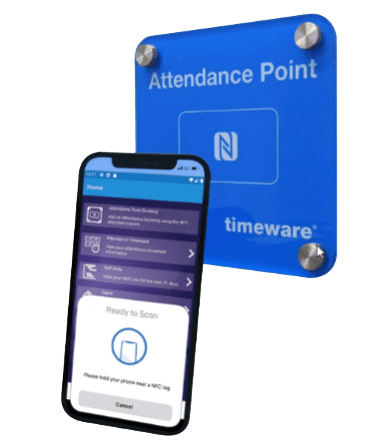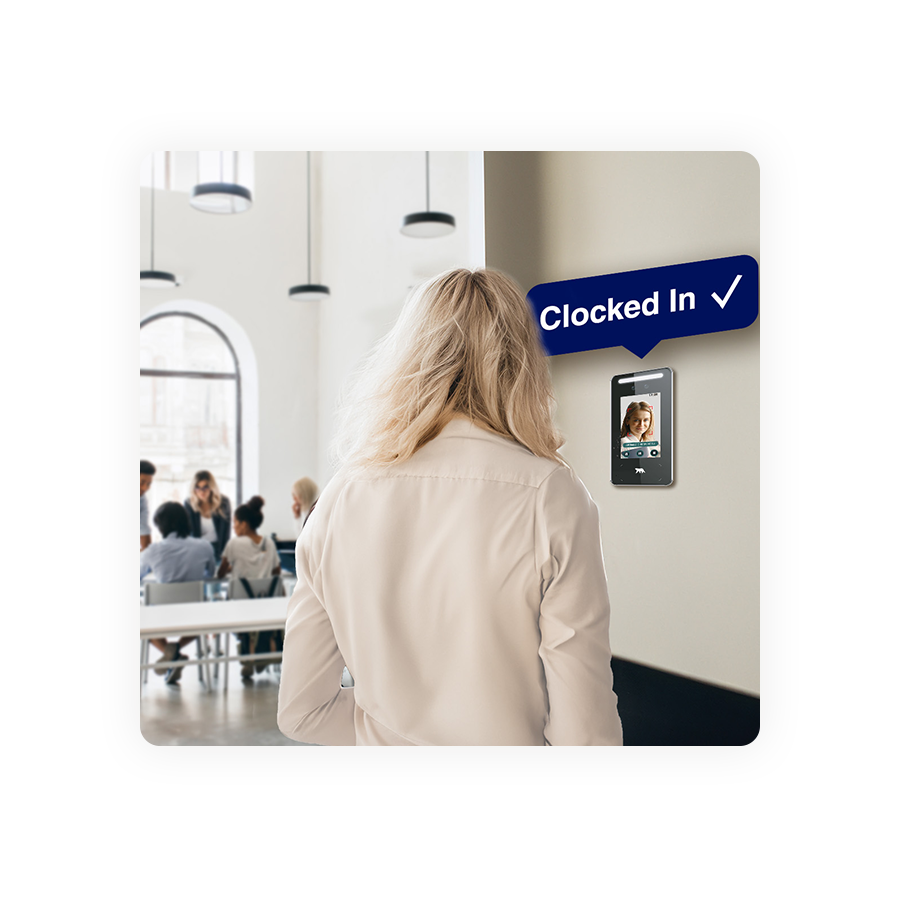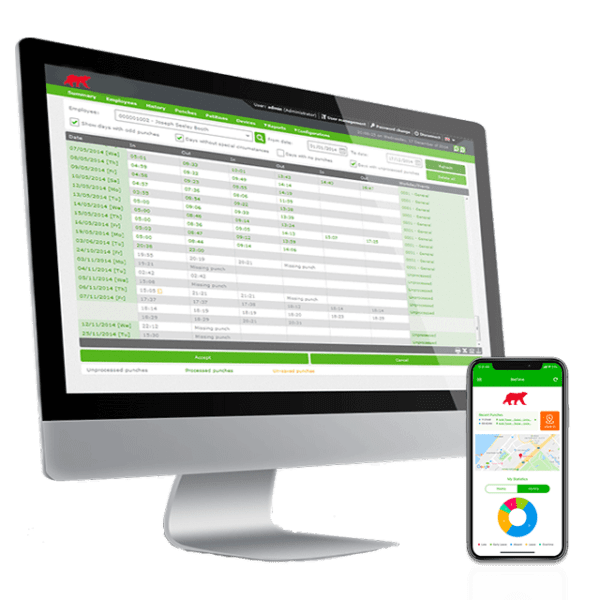
Safe Spaces, Happy Faces: How Employers Benefit When They Prioritise Workplace Security
Let’s delve into the myriad ways a modern time tracking system can save you time and improve productivity and efficiency.
In the bustling realm of small enterprises, the art of mastering time management is not just an option; it’s a necessity. Running a small business involves juggling countless tasks and amidst the whirlwind of daily operations, the quest to efficiently monitor employee hours emerges as a common challenge.
Enter the clocking in machine: a simple yet transformative tool poised to redefine your business’s approach to timekeeping.
At its core, a clocking in machine, or time clock, meticulously documents the comings and goings of your workforce. Sounds simple, but these devices are far from mundane; they are the linchpin in ensuring the accurate compensation of your team, which, in turn, fosters a harmonious work environment.
Gone are the days of the archaic punch card systems that first emerged in the 1880s. Technology has evolved and ushered in an era of sophisticated, secure, and precise clocking in solutions, tailored for the modern business landscape.
![]() Payroll Accuracy
Payroll Accuracy
Not only will the right system save you hours of administration time, but it will eradicate payroll discrepancies, a top cause of employee discontent. The integration of modern clocking in machines with established payroll systems represents a leap forward, automating payroll processes, enhancing efficiency, and mitigating errors.
Most companies have employees that often arrive late, or leave a little early, and no employer minds the occasional five minutes. However, habitual tardiness not only costs your business money in terms of lost productivity, it can also have knock on effects for production, and, can lead to your other employees resenting that one person who is habitually ‘getting away with it’. Accurate time tracking means fair pay for all.
Accurate data means better informed business decision making and planning, happier customers and a more profitable business. Hear from our customer, Windows Warehouse as to how to their biometric clocking in system has help them improve productivity.
You need to be able to prove the hours your team have worked and retain accurate records. This is whether they are on site, in the field or working from home. The legacy of hybrid working after the pandemic has meant new challenges in this area for small business owners.
You also need to be able to prove that they have taken their breaks. Effective clocking in systems for small businesses ensure that you stay the right side of employment law. You’ll find further information on your legal obligations here.
So implementing a clocking in machine can pave the way for a seamless operational flow, enhancing overall employee contentment in your business, but which is the right system for you?
The uniqueness of your business demands a clocking in system that resonates with its specific requirements. From RFID card solutions to the cutting-edge biometric technologies, the options are as diverse as they are innovative. There are pros and cons to each type of system.
 RFID Card / Fob Solutions
RFID Card / Fob SolutionsGreat for small businesses embarking on their digital journey, RFID solutions offer simplicity and ease of use and usually operate using a fob or card per employee.
However, they are not without their vulnerabilities, such as the risk of ‘buddy punching’. It’s simple for a friend or colleague to take their card or fob and clock that person in or out at the correct time without you ever knowing.
You may therefore fail to gain the efficiencies you hope for when implementing your new system.

Smartphone apps offer a versatile solution for managing attendance, particularly for teams spread across various locations or working from home. Our time and attendance software options for mobile clocking in allow you to ringfence areas, and create alerts.
This can be particularly helpful if they are visiting client sites, you have a definite record that they were on site if a client queries attendance.
GPS position is also logged but only at point of clocking in, to preserve your employees’ right to privacy.
NFC systems use a low cost ‘clocking in point’ in conjunction with your employees’ mobile phone. Need to prove a member of staff has visiting every floor in a building or covered a large area? You can place points around a site – no power required.
Biometric systems, leveraging unique personal identifiers like fingerprints, palm or facial features, stand as the zenith of clocking in technology. Once the preserve of conglomerates, these systems are now accessible to the budget- conscious small business, offering unparalleled accuracy and security.
conscious small business, offering unparalleled accuracy and security.
![]() Accuracy
Accuracy
Your employees can’t get anyone else to clock in for them and the data is unfalsifiable.
![]() Convenience
Convenience
Your team don’t have to remember cards or fobs, they are always carrying their credentials! The user experience is superior.
![]() Future proofing
Future proofing
Why wait to enjoy simpler time tracking when the technology of the future is affordable now?
It’s worth noting that most biometric readers have the capacity for using a fob or card instead of a biometric credential. Some individuals may refuse to use biometric clocking in machines, education and reassurance is important in your comms, making them understand that their data is safe and won’t be shared outside the system. Ultimately, they must be given the option to clock in another way if they are adamant. This helps keep you compliant with GDPR – read more.
![]() Mix ‘n’ Match
Mix ‘n’ Match
In today’s changing work environment you may need to combine onsite clocking in machines with mobile clocking in for employees who leave the office during their working day.
![]() Time Savings
Time Savings
Streamlining collation of payroll data and integration with your payroll systems (such as Sage) will save your managers and accountants hours and hours of valuable time, so they can focus on driving your business.

Time tracking systems offer many benefits to small businesses, there are also potential challenges that businesses should consider when implement a new clocking in system:
![]() Privacy Concerns: Employees may feel their privacy is being violated, especially with biometric or GPS-based systems. Employees may not be comfortable with their biometric data being stored or their location being constantly tracked. Communication is key to overcoming this – they need to know it’s going to be easier for them and be a more fair way of tracking working hours.
Privacy Concerns: Employees may feel their privacy is being violated, especially with biometric or GPS-based systems. Employees may not be comfortable with their biometric data being stored or their location being constantly tracked. Communication is key to overcoming this – they need to know it’s going to be easier for them and be a more fair way of tracking working hours.
![]() Cultural Impact: The use of time tracking systems could create a culture of distrust if employees feel they are being constantly monitored. This could negatively impact morale, productivity, and employee engagement unless communicated clearly. In reality, many firms see a morale boost – employees not pulling their weight can no longer hide and the rest of the workforce see this.
Cultural Impact: The use of time tracking systems could create a culture of distrust if employees feel they are being constantly monitored. This could negatively impact morale, productivity, and employee engagement unless communicated clearly. In reality, many firms see a morale boost – employees not pulling their weight can no longer hide and the rest of the workforce see this.
![]() Technical Issues: Technology is not foolproof. Biometric scanners might not always accurately read information, or other types of time clocks might malfunction. Internet or power outages can also interfere with digital systems. All of these issues can lead to inaccuracies in time records but these can be corrected retrospectively in the records with a full audit trail.
Technical Issues: Technology is not foolproof. Biometric scanners might not always accurately read information, or other types of time clocks might malfunction. Internet or power outages can also interfere with digital systems. All of these issues can lead to inaccuracies in time records but these can be corrected retrospectively in the records with a full audit trail.
![]() Cost: Time tracking systems can be expensive to purchase, install, and maintain. This might not be cost-effective for micro businesses.
Cost: Time tracking systems can be expensive to purchase, install, and maintain. This might not be cost-effective for micro businesses.
![]() Data Security: With digital systems, there is a risk of data breaches. It’s crucial for businesses to ensure they, and their supplier, have robust security measures in place to protect this data. Check any supplier’s cyber credentials.
Data Security: With digital systems, there is a risk of data breaches. It’s crucial for businesses to ensure they, and their supplier, have robust security measures in place to protect this data. Check any supplier’s cyber credentials.
![]() Legal Considerations: Different regions have different laws around time tracking and what kind of data employers can collect and store. Non-compliance with these laws can lead to legal issues and penalties.
Legal Considerations: Different regions have different laws around time tracking and what kind of data employers can collect and store. Non-compliance with these laws can lead to legal issues and penalties.
![]() Resistance to Change: As with any new system, there can be resistance from employees who are used to a certain way of doing things. Training and change management efforts will likely be needed to help employees adjust to the new system.
Resistance to Change: As with any new system, there can be resistance from employees who are used to a certain way of doing things. Training and change management efforts will likely be needed to help employees adjust to the new system.
As with any business decision, the potential drawbacks of time tracking systems must be weighed against their benefits. In most cases, the advantages of improved accuracy and efficiency can outweigh the disadvantages, but it depends on the specific circumstances of the business and the system chosen. A good time and attendance supplier will assist you with staying compliant and advise on good communication around the new clocking in system.
The clocking in device itself is only half of the picture. Complementing the clocking in devices themselves is the software running the system.
How simple or complex this needs to be will depend on a variety of factors:
This is not an exhaustive list.
Software is often on a subscription basis, determined by the number of users, devices and complexity of requirements that you choose.
It’s worth taking the time to properly scope out your requirements initially and it will save hours later! Your preferred supplier will help you with this.
You’ll also need to consider location and environmental factors as this could have implications for the durability of the device.
The evolution of work has necessitated adaptable clocking in solutions for remote and field-based employees, from rugged portable units designed for harsh environments to mobile apps equipped with GPS functionality and photographic verification.
In a food manufacturing facility, face scanner timeclocks may make more sense as employees may have donned gloves and be wearing face masks (the facial recognition still works when individuals are wearing masks).
Devices have different thresholds for this, if you have an environment that is extremely humid, then this should be mentioned to your time and attendance consultant as they will ensure they recommend a device with an appropriate IP rating.
It can be tempting to combine access control with time and attendance systems, but this can lead to confusion. Do your team start work the minute they walk through the door? Do they go out for lunch so they can clock out for their break? Are they walking out of the main exit at the exact moment their shift ends? Unlikely.
Generally it’s more effective to separate the two systems so you have clear reporting for both.
All employees have a way to clock in that suits them and doesn’t make them feel disadvantaged. Any fingerprint reader for example, shouldn’t be higher than 1.2m from the floor to allow for wheelchair users to reach it. Face readers must be set so they will pick up the correct angle to work for people of all heights.
Clearly, there are several different considerations when you’re thinking about implementing clocking in machines in your small business. It may feel a little overwhelming, but a great supplier will guide and support you through every step of the process.
Making a change to the way you track time in your small business will impact your management team and staff. Good communication as to why you’re doing this and the benefits for your employees is vital. Templates and guidance on this will save you time and keep you compliant.
Most suppliers will offer initial consultation, installation and a certain number of hours of support over a fixed period to ensure the system is configured to your needs, you’re fully trained and comfortable using every aspect of the system.
After this initial period there could be a charge.
If you have a high turnover of staff or are growing rapidly, you’ll want to consider such after-care provision implications in more depth.
Selecting the ideal clocking in machine for your small business is a delicate balance of need, budget, and business structure. Whether it’s the cost-effectiveness of RFID cards, the convenience of smartphone apps, or the unmatched security of biometric systems, or a combination of all three, the perfect solution is out there, ready to transform your approach to time management.
It’s time to invest in the right clocking in machine, and witness the transformative impact on your business operations. When you need guidance in navigating this crucial decision, our team of Time and Attendance Consultants is at your disposal, ready to advise you on the way to optimised time management. Contact us today.
You can call us on 0808 167 6002 (UK) or 016833368 (IRE) or pop your details below and we will get in touch.
